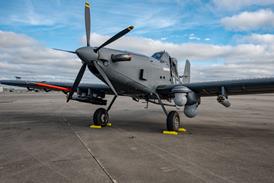THE TILT-ROTOR is a remarkable aircraft. With the "prop-rotor" nacelles vertical, it can hover, fly sideways and backwards and turn on the spot - just like a tandem-rotor helicopter. With the nacelles horizontal, it has the speed, range and cruising altitude of a conventional twin turboprop.
The Bell Boeing V-22 Osprey is the result of more than 40 years of tilt-rotor development, beginning with the experimental Bell XV-3, flown in 1955. The highly successful Bell XV-15 technology demonstrator was first flown in 1979 and is still being flown today.
First flown in 1989, the V-22 is the first tilt-rotor destined for production. It incorporates several new technologies, compared with the XV-15, including an all-composite airframe and fly-by-wire flight controls. The aircraft is being developed as a tactical transport for the US Marine Corps and a special-operations and combat-rescue aircraft for the US Air Force and Navy.
The tilt-rotor is an entirely new class of aircraft, introducing the capability to take off vertically, fly at 250kt (460km/h) at turboprop altitudes for more than 1,800km (970nm), then land vertically. Bell Boeing says that the V-22 is quieter than a helicopter - or a turboprop - because of a lower prop-rotor RPM and the lack of a noisy tail rotor.
In forward flight, with the nacelles horizontal, conventional fixed-wing controls (flaperons, elevators and rudders) are used. During conversion to vertical flight, control is transferred automatically to the prop-rotor swash plates which, just like in a helicopter, are used to control blade pitch in the hover. You can hear this happen. The converse occurs during transition to forward flight.
The two 12m-diameter prop-rotors each have three composite blades. For below-deck stowage, the blades fold parallel to the wing leading edge and the wing slew to lie along the top of the fuselage. This reduces width by over 25m, to 5.6m, but increases length by nearly 2m, to 19m.
Allison's T406 was developed specifically for the V-22. Flat-rated at 4,580kW (6,150shp), it has a 10min emergency-power rating of 5,090kW. A connecting shaft allows either engine to drive both prop-rotors, to enable flight on one engine in helicopter, conversion and fixed-wing modes.
Fuel is stored in the wing and landing gear sponsons, in crash-resistant self-sealing cells. Normal capacity is 7,600litres, but up to four auxiliary tanks can be installed in the cabin, holding an additional 9,200litres. Air-to-air refueling is also available.
The V-22 is designed to cruise at 275kt, with a 340kt, dash speed. Vertical rate of climb is 1,090ft/min (5.45m/s) in helicopter mode and 2,300ft/min in fixed-wing mode. Cruise ceiling is 26,000ft with both engines, and 11,300ft on one engine. Hover ceiling with both engines, out of ground effect, is 14,200ft.
Empty weight is about 15,000kg. Normal vertical take-off weight is 21,500kg, increasing to 25,000kg with a short take-off run. Maximum weight with auxiliary fuel and a short running take-off is 27,500kg. The cabin will accommodate 24 combat-equipped troops and two gunners, 30 passengers, or 9,000kg of cargo.
A full-width rear loading-ramp is hydraulically operated. There is provision for a 900kg-capacity cargo handling winch and roller rails. A single belly cargo-hook rated at 4,500kg, or two hooks with a combined limit of 6,800kg, can be fitted. Maximum forward speed with an under-slung load is 130kt, although the V-22 has carried a 1,800kg load at 175kt.
Range after a vertical take-off with 5,400kg payload is 2,200km, increasing to 3,300km with a short running take-off and 9,000kg payload, and to 3,900km with full auxiliary fuel and no payload. Self-deployment range with air-to-air refueling is more than 4,600km.
Anti-icing of the prop-rotor blades and spinners, engine air-intakes and cockpit windscreens allows operation in moderate icing. The landing gear will absorb heavy landings up to 3.6m/s vertical speed, and crashworthy crew seats and crash-attenuating troop seats are installed.
Source: Flight International























